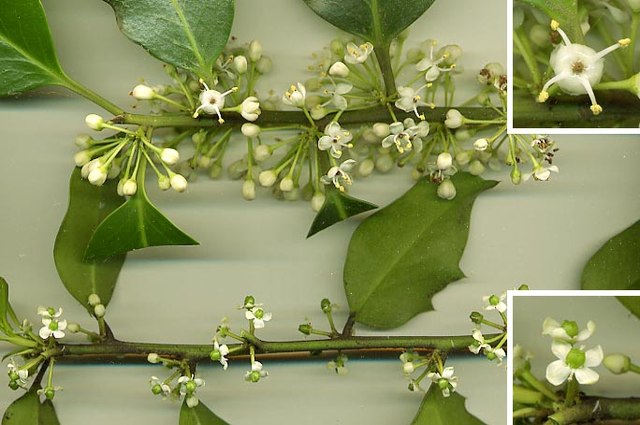Flowering plant sexuality
form of sexuality From Wikipedia, the free encyclopedia
Flowering plant sexuality describes some of the technical terms for common arrangements of flowers.[1]


Flowers
These terms for the sexuality of individual flowers:
- Perfect flowers have both male (androecium) and female (gynoecium) reproductive structures and include stamens and an ovary. Flowers that contain both androecium and gynoecium are called hermaphroditic. Examples of plants with perfect or bisexual flowers include the lily, the rose, and most plants with large showy flowers. A complete flower is a perfect flower with petals and sepals.
- Unisexual reproductive structures are either functionally male or functionally female. In floweing plants, this condition is also called imperfect, or incomplete.
Individual plants

Many plants have complete flowers with both male and female parts, others have only male or female parts, and still other plants have flowers on the same plant that are a mix of male and female flowers.
Some plants even have mixes that include all three types of flowers for which some flowers are only male, some are only female and some are both male and female.
A distinction needs to be made between arrangements in single plants versus the larger plant population.
Some plants also undergo what is called sex-switching like Arisaema triphyllum, which expresses sexual differences at different stages of growth. In some arums, smaller plants produce all or mostly male flowers, and as plants grow larger over the years, the male flowers are replaced by more female flowers on the same plant. Arisaema triphyllum thus covers a multitude of sexual conditions in its lifetime from nonsexual juvenile plants to young plants that are all male. As plants grow larger they have a mix of both male and female flowers and become large plants that have mostly female flowers.[2]
Other plant populations have plants that produce more male flowers early in the year, and as plants bloom later in the growing season, they produce more female flowers. In plants like Thalictrum dioicum, all plants in the species are either male or female.
Specific terms are used to describe the sexual expression of individual plants within a population:
- Hermaphrodite, a plant that has only bisexual reproductive units (flowers, conifer cones, or functionally-equivalent structures). In angiosperm terminology, a synonym is monoclinous from the Greek "one bed".
- Monoecious, an individual that has both male and female reproductive units (flowers, conifer cones, or functionally-equivalent structures) on the same plant, from the Greek for "one household".
Individuals bearing separate flowers of both sexes at the same time are called simultaneously or synchronously monoecious. Individuals that bear flowers of one sex at one time are called consecutively monoecious; plants may first have single-sexed flowers and then later have flowers of the other sex.
Protoandrous describes individuals that function first as males and then change to females; protogynous describes individuals that function first as females and then change to males. - Dioecious refers to a plant population having separate male and female plants. That is, no individual plant of the population produces both microgametophytes (pollen) and megagametophytes (ovules); individual plants are either male or female.[3] From Greek for "two households". Individual plants are not called dioecious; they are either gynoecious (female plants) or androecious (male plants).
- Androecious plants produce male flowers only and pollen but no seeds; they are the male plants of a dioecious population.
- Gynoecious, plants produce female flowers only and seeds but no pollen; they are the female plants of a dioecious population. In some plant populations, all individuals are gynoecious and use nonsexual reproduction to produce the next generation.
- Polygamy, plants with male, female, and perfect (hermaphrodite) flowers on the same plant.[4] A polygamous inflorescence has both unisexual and bisexual flowers.[5]
- Trimonoecious (polygamous) - male, female, and hermaphrodite floral morphs appear on the same plant.
Related pages
References
Wikiwand - on
Seamless Wikipedia browsing. On steroids.